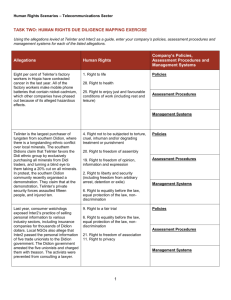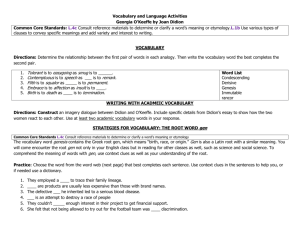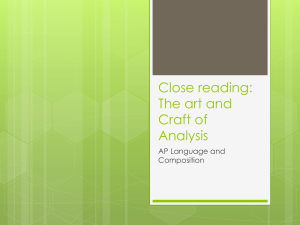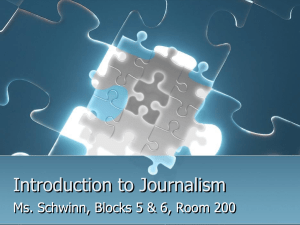Joan Didion and the New Journalism Movement
advertisement
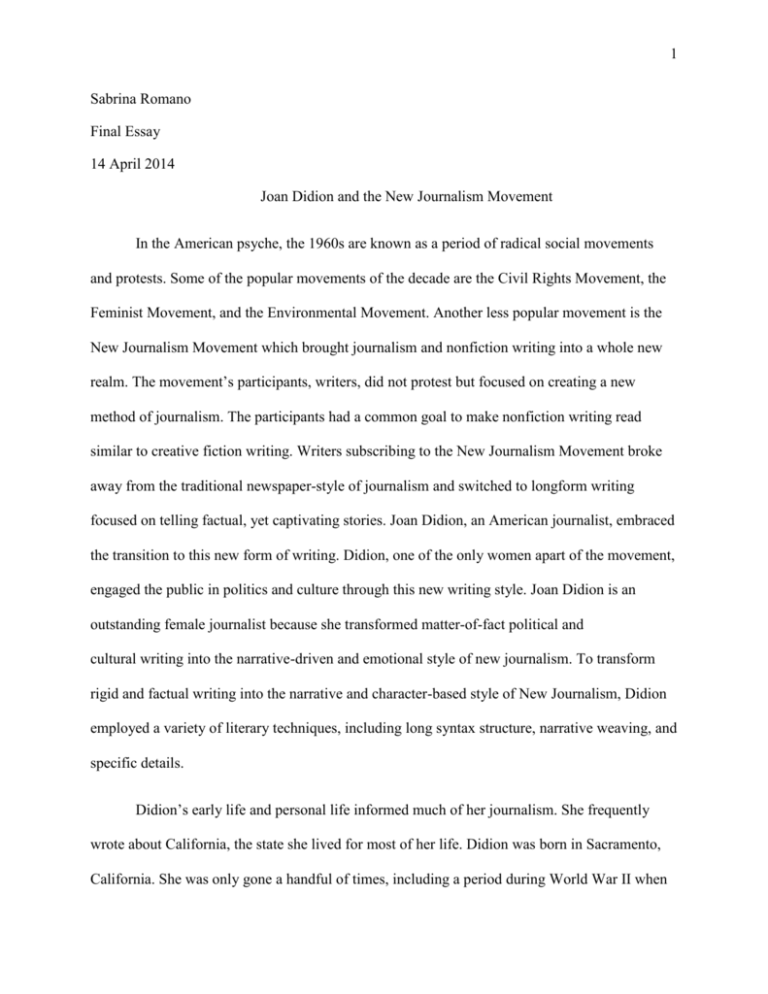
1 Sabrina Romano Final Essay 14 April 2014 Joan Didion and the New Journalism Movement In the American psyche, the 1960s are known as a period of radical social movements and protests. Some of the popular movements of the decade are the Civil Rights Movement, the Feminist Movement, and the Environmental Movement. Another less popular movement is the New Journalism Movement which brought journalism and nonfiction writing into a whole new realm. The movement’s participants, writers, did not protest but focused on creating a new method of journalism. The participants had a common goal to make nonfiction writing read similar to creative fiction writing. Writers subscribing to the New Journalism Movement broke away from the traditional newspaper-style of journalism and switched to longform writing focused on telling factual, yet captivating stories. Joan Didion, an American journalist, embraced the transition to this new form of writing. Didion, one of the only women apart of the movement, engaged the public in politics and culture through this new writing style. Joan Didion is an outstanding female journalist because she transformed matter-of-fact political and cultural writing into the narrative-driven and emotional style of new journalism. To transform rigid and factual writing into the narrative and character-based style of New Journalism, Didion employed a variety of literary techniques, including long syntax structure, narrative weaving, and specific details. Didion’s early life and personal life informed much of her journalism. She frequently wrote about California, the state she lived for most of her life. Didion was born in Sacramento, California. She was only gone a handful of times, including a period during World War II when 2 she, along with her mother and brother, followed their father, an officer in the Army Air Corps, as he traveled from post to post. After Didion graduated from the University of California, Berkeley, she left California for an extended amount of time. During college, she got a job at Vogue magazine in New York after winning first place in their essay contest. Didion started at Vogue as a research assistant and worked her way up to a contributing writer. In 1963, while still in New York, Didion wrote her first novel, Run River. Despite not selling very well, it earned her a second book contract. Soon after, her successful writing career took off. Before moving back to her home state of California, Didion married John Gregory Dunne, a Time magazine writer, in New York in 1964. They moved to Los Angeles, California and planned to stay for only six months but ended up calling Los Angeles their home for 20 years. In California, they adopted their only child and named her Quintana Roo.1 To understand Joan Didion and the New Journalism Movement, one must understand its context: the 1960s. The decade began with Americans feeling hopeful as John F. Kennedy took office. During this decade, Americans established a new standard for democracy. Many Americans realized they had the power to make a change and voiced their opinion. The Vietnam conflict rolled over from the 1950s and intensified into a full-blown war in the middle of the decade. The Civil Rights Movement gained popularity during the Sixties as thousands of African Americans protested segregation and unequal rights in the form of marches and sit-ins. In 1964, President Johnson passed the Civil Rights Act which made discrimination illegal.2 African Americans weren’t the only group organizing for a better future. Through the National Organization for Women and other women’s liberation groups, women fought for reproductive 1 2 "Joan Didion." Academy of Achievement. N.p., n.d. Web. 3 Apr. 2015. <http://www.achievement.org/autodoc/page/did0bio-1>. "The 1960s." History, n.d. Web. 8 Apr. 2015. <http://www.history.com/topics/1960s>. 3 rights and gender equality.3 The Environmental Movement gained traction after Rachel Carson authored Silent Spring and influenced legislation.4 Among these movements dealing with the government and legislation, there existed one movement which focused on storytelling and art: the New Journalism Movement. For writers, the 1960s, a time when social change was popular, seemed like the perfect time to revolutionize their craft. New Journalism began in the 1960s with writers who wanted a style outside of the traditional and rigid journalism and nonfiction realm to express their ideas. According to Encyclopedia Britannica, “the genre combined journalistic research with the techniques of fiction writing in the reporting of stories about real-life events.”5 The interview process in traditional journalism and new journalism is very similar; in both forms of writing, journalists would interview their subjects multiple times and spend hours with them. However, the New Journalism writing style is significantly different from traditional journalism. New journalism focused on storytelling and engaging the reader. “[New Journalists] constructed well-developed characters, sustained dialogue, vivid scenes, and strong plotlines marked with dramatic tension. They also wrote in voices that were distinctly their own.”6 Tom Wolfe, Norman Mailer, Gay Talese, and Truman Capote were some of the first writers to subscribe to the fiction-like writing style. Unlike other movements occurring in the 1960s, writers did not necessarily gather and plot their plan to create a new style of journalism. Instead, the genre became more common as 3 Napikoski, Linda. "1960s Feminist Activities." About Education, n.d. Web. 8 Apr. 2015. <http://womenshistory.about.com/od/feminism/tp/1960s_feminist_activities.htm>. 4 Koch, Wendy. "Carson's 'Silent Spring' spurred environmental movement." USA Today 27 Sept. 2012. Web. 8 Apr. 2015. <http://usatoday30.usatoday.com/news/nation/story/2012/09/27/carsons-silent-spring-spurred-environmentalmovement/57845706/1>. 5 Fakazis, Liz. Encyclopedia Britannica. n.d. Web. 9 Apr. 2015. <http://www.britannica.com/EBchecked/topic/411713/NewJournalism>. 6 Fakazis, Liz. Encyclopedia Britannica. 4 magazines like New York and Esquire published articles in the New Journalism style.7 New Journalists also published their work in anthologies or their own books.8 Didion, one of the only females associated with the beginning of the New Journalism Movement, achieved large literary success publishing her New Journalism writing. Didion used the new journalism style to write about politics in an engaging and less matter-of-fact way. California in the mid-1960s is the subject for some of her most-prized journalism. In “California Dreaming,” a piece in Slouching Towards Bethlehem, Didion explores The Center for the Study of Democratic Institutions’ politics and rhetoric. In this piece, Didion writes from the perspective of an expert on the Center and employs a long syntax structure. “What these highly skilled public-relations experts do, besides clarifying the basic issues and giving a lift to Bennett Cerf…is to gather every weekday for a few hours of discussion, usually about one of several broad areas that the Center is concentrating upon any given time—The City, say, or The Emerging Constitution.”9 In particular, this sentence is clear and enlightening in its lengthiness because Didion details the daily task of those working at the Center. By taking the perspective of an expert, she gives the reader a full idea of what employees at the Center do. When Didion writes as an expert on a subject, what she writes has less room for interpretation. If done amateurishly, the long sentence structure could inhibit the piece’s clearness. In this case, the lengthy syntax structure enhances Didion’s piece. The sentences provide the reader with a clear picture and message. These long sentences illustrate the complexity of the subject to the reader. In a journal article in the Sewanee Review, Robert Lacy wrote that Didion’s long-winded sentences add to her writing: “And she’s good at the long sonorous ones that loop back and forth 7 Murphy, James E. "The New Journalism: A Critical Perspective." Journalism Monographs (1974). Web. 9 Apr. 2015. <http://files.eric.ed.gov/fulltext/ED096677.pdf>. 8 Fakazis, Liz. Encyclopedia Britannica. 9 Didion, Joan. We Tell Ourselves Stories in Order to Live. New York: Alfred A. Knopf, 2006. Print. Rpt. of Slouching Towards Bethlehem. 1968. 5 within themselves like a circus aerialist before arriving breathtakingly at their conclusions.”10 Didion’s long sentences illustrate to the reader that she is not jumping to any conclusions. In her lengthy sentences, it is as if she is exploring all areas of the issue before forming her opinion. Her lengthy syntax structure allows the reader to take in each aspect of the issue and arrive at Didion’s conclusion. If the reader doesn’t agree with Didion, he or she can at least be aware of Didion’s reasoning. Didion’s long sentence structure arouses emotion in the reader and enables the reader to connect with her story. Unlike traditional journalism, New Journalism was allowed to be subjective as long as it maintained its factualness. Before the New Journalism Movement, many Americans might not have been interested in reading about politics in a newspaper because the writing could be considered dry and difficult to connect to. The long sentences are relatable because they have a conversational quality. Sometimes, people speak in long sentences with multiple clauses to achieve their point. Didion’s syntax structure keeps the reader’s interest and illustrates the complexity of her subject. Didion became fascinated with the 1960s and continued writing about the decade well into the 1970s. In “The White Album,” published in The White Album in 1979, Didion reflects on the mid-to-late 1960s and examines her role in and perspective on the period. To illustrate her role and perspective to the reader while primarily detailing social events, Didion weaves in her own narrative. She is honest about her position in the narrative and how she is viewing a myriad of political events through her personal lenses. Part of Didion’s perspective is influenced from her suffering with nausea and vertigo. 10 Lacy, Robert. "Joan Didion: Daughter of Old California." Sewanee Review (2014). MLA International Bibliography. Web. 11 Apr. 2015. 6 “The tests mentioned…were administered privately, in the outpatient psychiatric clinic at St. John’s Hospital in Santa Monica, in the summer of 1968, shortly after I suffered the “attack of vertigo and nausea” mentioned in the first sentence and shortly before I was named Los Angeles Times “Woman of the Year.” By way of comment, I offer only that an attack of vertigo and nausea does not now seem to me an inappropriate response to the summer of 1968.”11 Didion is able to skillfully offer her opinion on the decade through her narrative of dealing with nausea and vertigo. In other words, she is saying that the 1960s was a whirlwind of a decade complete with overwhelming social events. By being open about her mental state during that period, Didion is adding a sense of emotional vulnerability to her writing. She grasps the reader’s attention by saying that a strong response to that summer is completely valid. The reader wants to continue reading to learn how she perceived those events that they possibly caused or led to spells of nausea and vertigo. In The Quarterly Review, Thomas Reinhart explains the multiple literary devices Didion incorporates through her straight forward narrative. “Always alert to the comfort of narrative simplicity, she is less alert to the pleasures of complexity, disjointedness, and irony that so conspicuously belong to her own kind of writing.”12 For Reinhart, it is ironic that in the retelling of a breakdown, the reader still views Didion as an authoritative narrator.13 For the reader, Didion’s authority is derived from how she owns her experiences and emotions. Didion capitalizes on the notion that her experience during the 1960s was unique and relays that to the reader. 11 Didion, Joan. We Tell Ourselves Stories in Order to Live. New York: Alfred A. Knopf, 2006. Print. Rpt. of The White Album. 1979. 12 Reinert, Thomas. "Joan Didion and Political Irony." A Quarterly Review 15.3 (1996). MLA International Bibliography. Web. 11 Apr. 2015. 13 Reinert, Thomas. "Joan Didion and Political Irony." 7 Didion incorporates her personal narrative in the popular narratives of the 1960s. She begins the piece with an examination of how people create and rely on stories for satisfaction, lessons, or knowledge. She uses this introduction as a foundation for her to tell plausible narratives about and provide social commentary on the violence in Los Angeles. In the fifth section of the piece, Didion writes about Huey Newton and the Black Panthers. Didion incorporates her own narrative while detailing how Huey Newton ended up in jail. Before she includes her own narrative, Didion outlines the subjects she will be exploring in her piece. In a sense, the piece has an objective aspect and, if written in the traditional style, could have been written for a newspaper: “I am telling you neither that Huey Newton killed John Frey nor that Huey Newton did not kill John Frey, for in the context of revolutionary politics Huey Newton’s guilt or innocence was irrelevant. I am telling you only how Huey Newton happened to be in the Alameda County Jail, and why rallies were held in his name, demonstrations organized whenever he appeared in court.”14 This statement often serves as the unsaid disclaimer for a newspaper article. Yet, this honesty enables her to emotionally connect to the reader. Didion makes it clear that she is not writing propaganda or attempting to fool the reader in any way. Instead of only writing about the events that surrounded Huey Newton, Didion expands the story to include her own narrative, her reaction to his ordeal, and her dissection of the cultural implications of the event. “For a long time, I kept a copy of this testimony pinned to my office wall, on the theory that it illustrated a collision of cultures, a classic instance of an historical outsider 14 Didion, Joan. Rpt. of The White Album. 1979. 8 confronting the established order at its most petty and impenetrable. This theory was shattered when I learned that Huey Newton was in fact an enrolled member of the Kaiser Foundation Health Plan, i.e. in Nurse Leonard’s words, “a Kaiser.”15 By including her own actions in the piece, she expresses her hopefulness and subsequent hopelessness to the readers. In this case, Didion is an outside observer to events. Through this outsider position, Didion is able to provide a sense of morality and complexity to the reader. Reinhart explains how these seemingly minute instances that Didion includes in her writing can easily magnify to represent a larger occurrence. “The moral is that simple tropes, simple scenarios setting good and evil in opposition to each other, will not suffice to grasp history and politics, and what emerges in their place is irony.”16 The writing style synonymous with the New Journalism Movement enabled Didion to be ironic and touch on what Americans’ thought about political events. When writing about the radical culture of the 1960s, Didion didn’t only focus on social movements. Her view of culture included events that made headlines all over her beloved state of California. This was the case for Gordon Miller’s murder, supposedly committed by his wife, Lucille Miller. This scandalous murder case took some of the public’s attention. Instead of writing a breaking news story or a second-day feature on the event, Didion decided to write an essay about the event, specifically about the fateful night of Gordon Miller’s death and the resulting trial and general aftermath. This longform writing allowed her to incorporate descriptions of the California scenery that surrounded the murder. In this essay, “Some Dreamers of the Golden Dream” in Slouching Towards Bethlemem Didion includes many specific details 15 16 Didion, Joan. Rpt. of The White Album. 1979. Reinert, Thomas. "Joan Didion and Political Irony." 9 which enhance the events and match the tone she wants to achieve. In a sense, Didion creates a new but not untrue reality. When describing Banyan Street, the sight of the murder, Didion wrote, “Like so much of this country, Banyan suggests something curious and unnatural. The lemon groves are sunken, down a three-or four-foot retaining wall, so that one looks directly into their dense foliage, too lush, unsettlingly glossy, the greenery of a nightmare; the fallen eucalyptus bark is too dusty, a place for snakes to breed.”17 While including undisputable facts, such as the type of trees and the height of the retaining wall, Didion also imposes her own details onto the story, such as her description of the leaves and their association with a nightmare. The notion that the leaves are “unsettlingly glossy” is subjective; another person at the scene may perceive the leaves to be the exact opposite. Didion is careful in her writing and doesn’t say that snakes breed on Banyan Street, but instead say that it is a suitable place for that to happen. Snakes are known for being sly and dangerous. By placing the possibility of snakes in the scene, Didion is making Banyan Street feel eerie. Didion’s detail creates a vivid image of Banyan Street for the reader. Some scholars believe that the specific details found in Didion’s writing are exaggerated or not completely true. “In fact, Didion is so unlike a camera that she occasionally creates details for her stories. The journalist’s invention of detail, usually through composite characterization or the reporting of characters’ unspoken thoughts, has been the focus of most attacks on New Journalism’s accuracy.”18 Didion’s subjective details make any story captivating and therefore, engage the reader. There are some details that Didion doesn’t know because her character doesn’t remember. Because the genre is a subset of nonfiction, Didion cannot create details in the place 17 Didion, Joan. Rpt. of Slouching Towards Bethlehem. 1968. Muggli, Mark Z. "The Poetics of Joan Didion's Journalism." American Literature: A Journal Of Literary History, Criticism, And Bibliography (1987). MLA International Bibliography. Web. 9 Apr. 2015. 18 10 of forgetfulness. In these cases, which happened with Lucille Miller in “Some Dreamers of the Golden Dream,” Didion is honest about her character’s lapse in memory and tells the story with uncertainty. “Lucille Miller remembers reaching over to lock his door as she backed down the driveway…There is some confusion in Lucille Miller’s mind about what happened between 12:30 a.m., when the fire broke out, and 1:50 a.m., when it was reported.”19 This honesty builds Didion’s credibility. She is being clear with the reader and not piecing together a story with false information. Many of the details in “Some Dreamers of the Golden Dream” are particular to the New Journalism Movement because they aren’t necessary for a traditional journalism article. For example, if Didion wrote an article about the fire in Lucille Miller’s car on Banyan Street, Didion would primarily include the information pertaining to who, what, when, where, and why. The height of the lemon groves or the density or their shrubbery is not necessary information. These details help the reader recreate the fateful night of Gordon Miller’s death. Also, when Didion refers to Lucille Miller, she uses her whole name instead of just her last, which doesn’t match newspaper style. Using the character’s whole name allows the reader to connect to her more and view her as a complex character. Not only did New Journalism thrive because it originated in the 1960s, a time popular for social movements, but also because of Didion. Her emotional and narrative-driven writing garnered the public’s attention. Readers responded favorable to Didion’s writing style; it was nothing like the traditional, newspaper-style journalism they were used to which conveyed facts and not usually emotion. She found political and cultural subjects, events, and places and expanded them into engaging stories. Didion’s lengthy syntax structure, narrative weaving, and 19 Didion, Joan. Rpt. of Slouching Towards Bethlehem. 1968. 11 inclusion of specific, and sometimes subjective, details draw the reader in and enable him or her to become emotionally invested in the story. Through her use of literary techniques, Didion makes the reader to care about the characters and where the story takes place. Works Cited Didion, Joan. We Tell Ourselves Stories in Order to Live. New York: Alfred A. Knopf, 2006. Print. Rpt. of Slouching Towards Bethlehem. 1968. Didion, Joan. We Tell Ourselves Stories in Order to Live. New York: Alfred A. Knopf, 2006. Print. Rpt. of The White Album. 1979. Fakazis, Liz. Encyclopedia Britannica. n.d. Web. 9 Apr. 2015. <http://www.britannica.com/EBchecked/topic/411713/New-Journalism>. "Joan Didion." Academy of Achievement. N.p., n.d. Web. 3 Apr. 2015. <http://www.achievement.org/autodoc/page/did0bio-1>. Koch, Wendy. "Carson's 'Silent Spring' spurred environmental movement." USA Today 27 Sept. 2012. Web. 8 Apr. 2015. <http://usatoday30.usatoday.com/news/nation/story/2012/09/27/carsons-silent-springspurred-environmental-movement/57845706/1>. Lacy, Robert. "Joan Didion: Daughter of Old California." Sewanee Review (2014). MLA International Bibliography. Web. 11 Apr. 2015. Muggli, Mark Z. "The Poetics of Joan Didion's Journalism." American Literature: A Journal Of Literary History, Criticism, And Bibliography (1987). MLA International Bibliography. Web. 9 Apr. 2015. Murphy, James E. "The New Journalism: A Critical Perspective." Journalism Monographs (1974). Web. 9 Apr. 2015. <http://files.eric.ed.gov/fulltext/ED096677.pdf>. Napikoski, Linda. "1960s Feminist Activities." About Education, n.d. Web. 8 Apr. 2015. <http://womenshistory.about.com/od/feminism/tp/1960s_feminist_activities.htm>. Reinert, Thomas. "Joan Didion and Political Irony." A Quarterly Review 15.3 (1996). MLA International Bibliography. Web. 11 Apr. 2015. "The 1960s." History, n.d. Web. 8 Apr. 2015. <http://www.history.com/topics/1960s>. 12
